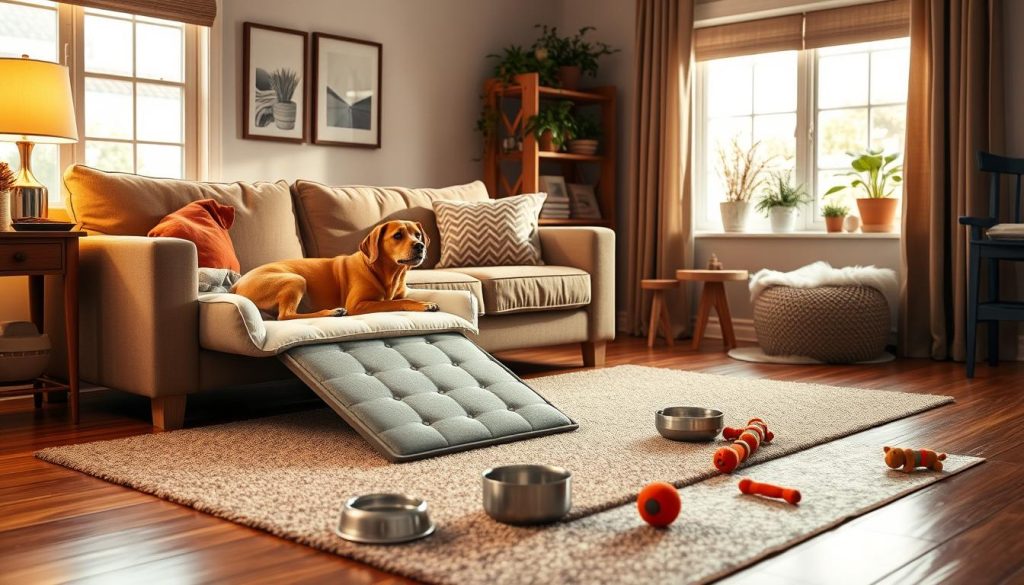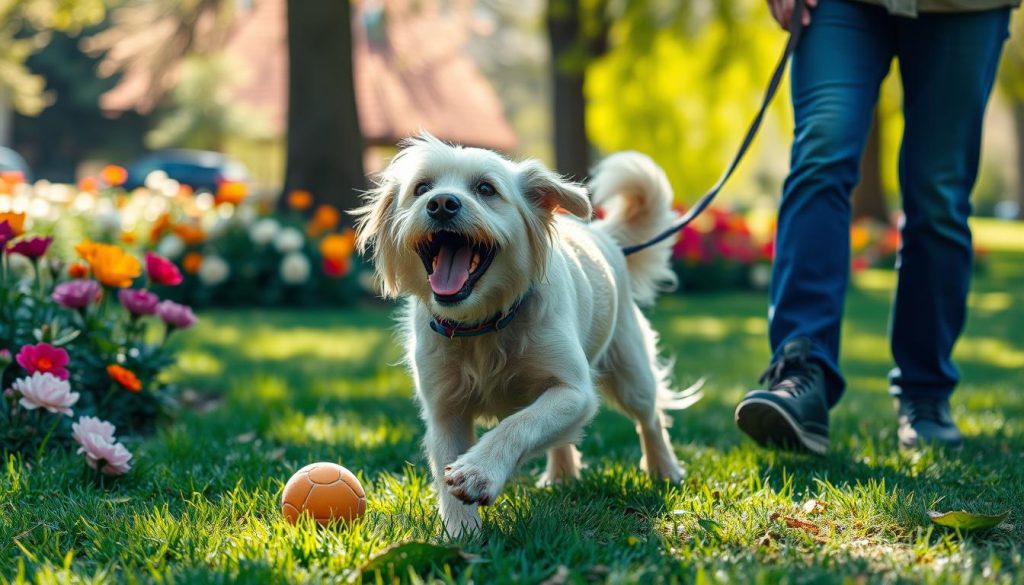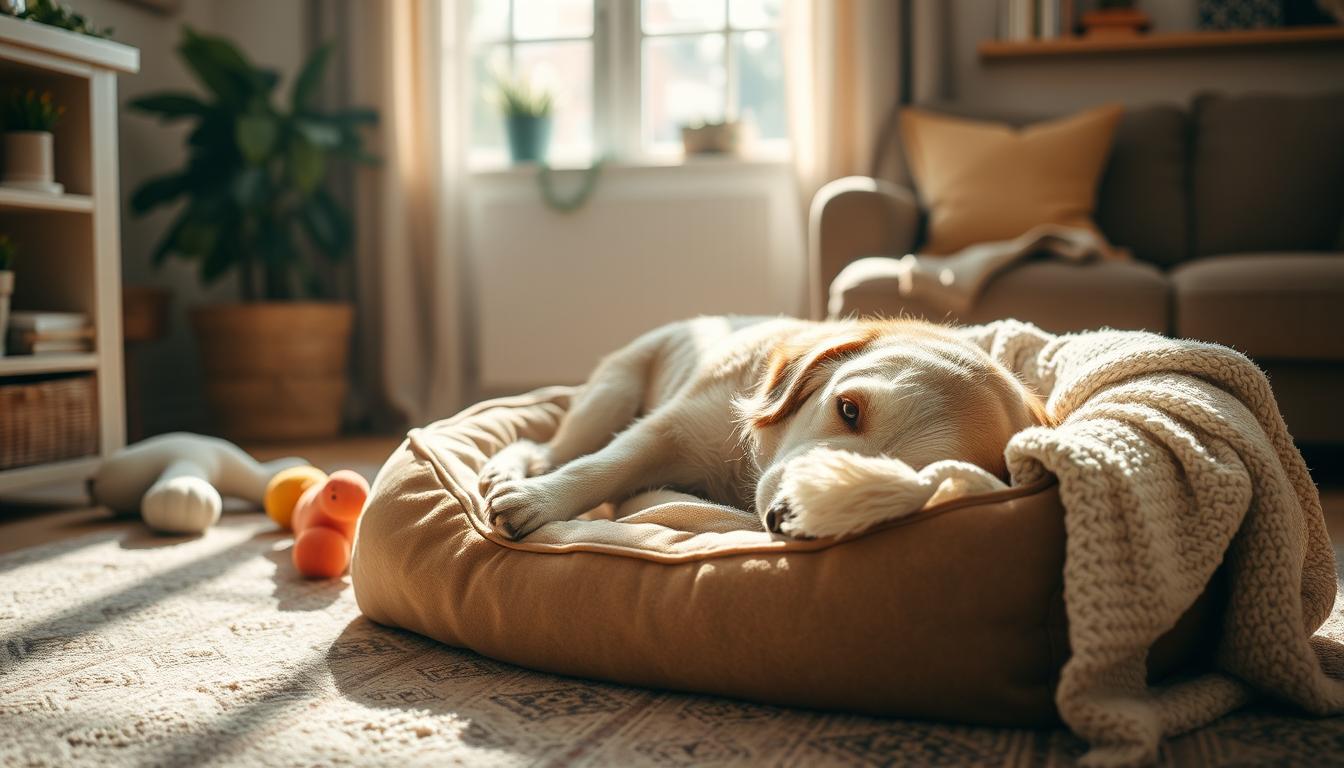As our beloved canine companions age, their needs change. Whether your dog is slowing down or is older, it’s key to know how to care for them. In this article, I’ll share important tips and tricks for caring for an aging dog.
Understanding your senior dog’s nutritional needs is crucial. Creating a comfortable living space and adapting your grooming routine are also important. I’ll also talk about finding activities to keep them mentally and physically active.
Monitoring your senior dog’s health and recognizing age-related issues are vital. Providing emotional support is also important during their twilight years.
With the right care, your senior dog can thrive and enjoy their golden years. Let’s explore the essential tips and tricks for caring for your beloved senior dog.
Understanding Your Senior Dog’s Changing Needs
As our beloved canine companions age, their needs change. It’s key to know the signs of aging in dogs and how their diet needs shift. By paying attention to these changes, we can give our senior dogs the care they need in their golden years.
Signs of Aging in Dogs
Watching for changes in your senior dog’s behavior and physical abilities is important. Look for signs like less activity, hearing or vision loss, and changes in sleep. They might also be less responsive to commands or act differently with others.
How a Dog’s Nutritional Requirements Evolve
Older dogs have different nutritional needs than younger ones. They often need a diet with fewer calories and more fiber to stay healthy and support their digestion. They also might need more vitamins and minerals, like glucosamine and chondroitin, to keep their joints healthy and mobile.
| Nutritional Needs | Young Dogs | Senior Dogs |
|---|---|---|
| Calorie Intake | Higher | Lower |
| Fiber Content | Lower | Higher |
| Glucosamine and Chondroitin | Lower | Higher |
Understanding our senior dogs’ changing needs helps us tailor their diet and care. This way, we support their health and well-being as they age.
Adapting Your Home for Senior Dog Care

As our dogs get older, their needs change. It’s key to make their living space comfortable and easy to get around. A few simple changes can greatly improve your senior dog’s life and help them move around better.
Creating a Comfortable Living Space
To make your home senior dog-friendly, consider these tips:
- Install non-slip surfaces: Prevent falls and improve traction by adding non-slip rugs, mats, or adhesive strips to smooth flooring surfaces.
- Provide soft, orthopedic bedding: Invest in a comfortable, supportive bed or cushion to help alleviate joint pain and pressure points.
- Ensure easy access to essentials: Place your dog’s food, water, and resting areas on the same level, making them easily accessible without requiring stairs or jumping.
- Incorporate ramps or steps: If stairs are unavoidable, add pet-safe ramps or steps to help your senior dog navigate them with ease.
- Maintain a clutter-free environment: Minimize tripping hazards by keeping walkways clear and organizing your home to provide ample space for your dog to move around.
By making your home senior dog-friendly, you can create a safe, comfortable space. This supports their well-being and helps them enjoy their golden years.
Senior Dog Care: Grooming and Hygiene

As our beloved canine companions age, their grooming and hygiene needs change. Proper grooming and hygiene are key to keeping them healthy and happy. Here are some tips to help your senior dog look and feel their best.
Bathing and Brushing for Senior Dogs
Bathing a senior dog may need to be done more often. Their skin and coat can get drier and more prone to buildup. But, don’t over-bathe as it can strip essential oils. Use a gentle, moisturizing shampoo and lukewarm water.
Make sure to dry your senior dog well to prevent chills. Regular brushing helps distribute natural oils, removes loose hair, and keeps their coat healthy.
Nail Trimming for Senior Dogs
As dogs age, their nails grow faster and need more trimming. Neglected nails can cause discomfort and health issues. When trimming, be gentle and consider having a groomer or vet do it, as senior dogs may be less tolerant.
Dental Care for Senior Dogs
Dental health is vital for senior dogs, as dental disease can lead to other health problems. Brush their teeth regularly with a soft-bristled toothbrush and dog-safe toothpaste. Professional cleanings by your vet may also be needed to keep their mouth healthy.
| Grooming Task | Frequency for Senior Dogs |
|---|---|
| Bathing | Every 4-6 weeks |
| Brushing | 2-3 times per week |
| Nail Trimming | Every 4-6 weeks |
| Dental Cleaning | As recommended by your veterinarian |
By focusing on your senior dog’s grooming and hygiene, you can help them stay healthy and confident. Work closely with your vet to tailor their grooming routine to their needs.
Keeping Your Senior Dog Active and Engaged

As our dogs get older, it’s key to keep them active and mentally sharp. Senior dogs might not have the same energy, but low-impact exercises and mental games can make a big difference. Let’s look at ways to keep your aging dog happy and active.
Low-Impact Exercise Ideas
It’s vital for senior dogs to stay active, but we need to choose exercises that are easy on their bodies. Here are some good options:
- Short, leisurely walks around the neighborhood
- Swimming in a pool or lake (with supervision)
- Gentle playtime with toys that encourage gentle movement
- Gradually building up to light jogging or hiking on soft, even terrain
Mental Stimulation Activities
It’s just as important to keep your senior dog’s mind active. Activities that challenge their curiosity and problem-solving skills can help prevent cognitive decline. Try these enrichment activities with your senior dog:
- Interactive puzzle toys that dispense treats
- Clicker training to teach new commands or tricks
- Scent-based games that encourage sniffing and exploration
- Rotating a variety of chew toys and food puzzles
By mixing low-impact exercise with mental games, you can help your senior dog stay physically and mentally fit. Remember, every dog is different, so adjust these activities to fit your dog’s needs and likes.
Senior Dog Care: Monitoring Health and Well-being
As our dogs get older, it’s vital to watch their health closely. Regular vet visits and early care help them live their best years. This ensures they enjoy their golden years fully.
Common Age-Related Health Issues
Older dogs face many health problems. Some common ones include:
- Arthritis: This causes pain and limits their movement and comfort.
- Cognitive Decline: Like humans, dogs can lose mental sharpness, leading to confusion and behavior changes.
- Organ Dysfunction: Aging affects vital organs like the kidneys, liver, and heart. We need to monitor and manage this closely.
It’s important to notice these health changes and work with vets to manage them. This way, we can give our senior dogs the best care.
By being proactive and addressing concerns, we can keep our senior dogs healthy. Regular vet visits, diet changes, and a caring home are key. These actions help our older pets live comfortably and with dignity.
Providing Emotional Support for Your Senior Dog
As our beloved canine companions age, their emotional needs change. Caring for a senior dog means understanding their emotional state better. It’s about providing constant support to make their golden years comfortable and happy.
Spending quality time with your senior dog is key. Set aside moments each day for activities they love. This could be a walk, cuddling, or just sitting together. These moments help them feel secure and ease the stress of aging.
Physical affection is also vital for their emotional well-being. Gentle petting, soothing brushing, and hugs can calm them. Pay attention to their cues for affection to build trust and a stronger bond.
Keeping your senior dog loved and secure is crucial. Stick to a peaceful routine and create a cozy space for them. Surround them with familiar toys and blankets for comfort and stability.
Meeting your senior dog’s emotional needs strengthens your bond and reduces stress. With patience and a focus on their well-being, you can help them face aging’s emotional challenges with grace.
Senior Dog Care: Preparing for the End of Life
As our beloved senior dogs age, we face a hard truth. It’s never easy to think about their end of life. But being prepared can make it less daunting.
Recognizing signs that it may be time for euthanasia is key. This way, our furry friends can pass on with dignity and little suffering.
Euthanasia for older pets is a personal choice. It’s vital to talk to your vet to understand your options. When the time comes, I’ll arrange their final care, like pet cremation or burial.
This can be emotionally tough. But it’s important to honor my pet’s memory and find closure.
Coping with the loss of a senior dog is hard. I’ll need time to mourn, sharing memories, creating a memorial, or seeking support. The pain of losing a furry friend may stay, but I’ll celebrate the joy and love they gave me.

